

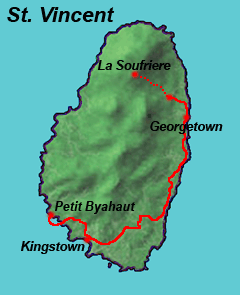
|
Today was our hike to the La Soufriere volcano on St. Vincent. La Soufriere is the northernmost and youngest volcano on St. Vincent. Its last eruption was in 1976, and the crater still steams today. The volcano is 4003 feet high and there are two hiking trails that go to the summit -- one trail from the Eastern side of the island, and a longer trail from the leeward coast (Western side of the island). On July 17th we hiked up the Eastern, and more popular trail, to the summit.
Before we start the hike, we packed. Brian (of Petit Byahaut) supplied us with lunch and four water bottles, which we stuck in a backpack. When we were planning the vacation, I expected to bring my Nikon camera on this hike and brought a camera-case backpack all the way from Boston just for the hike. But the weather was threatening rain and the air was still too humid to bring out the expensive camera. So I left it behind. Instead I brought the Canon Elph in its water proof case. With that and two raincoats (which we also packed) we were almost ready.
Daphne also need to bring hiking poles. Daphne had injured her knee a few years back and without hiking poles, she takes a risk of damaging it especially on steep descents. So it was bring the hiking poles, or skip the hike. Now the hiking poles collapse down to a pretty small size (for hiking poles), but they were still pretty large. Before the trip we ended up buying a new roomy duffle bag with wheels that was long enough to fit the hiking poles (and also the snorkeling fins).
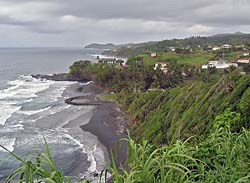 |
The trip started at 8:30am (1), with a short boat ride to the next cove (there are no roads to Petit Byahaut), where we met our guides. Our guides for the hike were from Robert Taxi, the same company that picked us up at the airport. Our driver was named Elvis and our hiking guide was named Elroy. Both were very friendly. We were the only guests on the tour.
Once in the taxi, we had a long ride ahead of us. It took approximately two hours to drive to the trail head. Elvis started by driving through Kingstown, then up the highway on the Atlantic coast, north to the volcano. While we drove, our guides talked a bit about the island and the various towns were going though. We saw lots of farms growing bananas (2), corn, peanuts, pineapple and taro -- only they don't call it taro here. They called it something else. But I recognized it from Hawaii.
Elvis was happy to stop whenever we wanted, to take pictures or to just admire the view. But we ended up only stopping a few times for pictures of the Atlantic coast (and this).
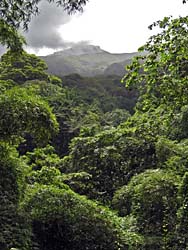 |
St. Vincent is in the process of rebuilding the windward coast highway. In one section, they had to detour us off the road and along a dirt road that went first through a forest and then a small village. The road was solid mud and very rutted. It was not wide enough for two cars and there were lots of places where we had to pull over for traffic. I mention this part of the trip because it was so memorable. Not only was it clear that the road would be impassable by two wheel cars in just a few weeks (at the rate it seems to be deteriorating). But the trip brought us through a very poverty stricken section of the island. Not the usual nice looking towns they reserve for the tourists.
Past the detour was the town of Georgetown, where we stopped to buy drinks to camel up for the trip (3). A good chance for Daphne to try some of the local sodas, not available in the United States. Then on to the trail head.
As I mentioned earlier, La Soufriere is 4003 feet high. The trail head is around 1000 feet above sea level. That only left 3000 feet to climb. Elvis dropped us off (with Elroy, the guide) and left (he went to spend time with his family in Georgetown). It was 10:35am.
The first part of the trip was through a rain forest. At the beginning we were walking along a narrow ridge. The ridge dropped off precipitously on both sides, and was only 10 feet wide in spots. Elroy said that the ridge was formed by a distant past lava flow. Most of the trail is steep. Sometimes very steep. The forest service maintains the trail and uses tree trunks to build stairs in the steepest sections. But the whole trail was up, and up and more up (4).
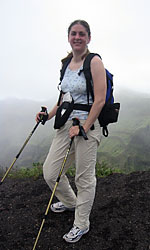 |
After the first one quarter of the climb, I took out water number one, and Daphne and I finished it. Now I was worried; three more water bottles left and we had only done a small part of the hike. We still had three quarters of the climb, plus lunch and the descent left.
The rain forest started off with bamboo and switched over to palm and fern and lots of other trees that I did not recognize. The forested section of the trail goes on for two-thirds of the trip (2000 feet of the climb).
At one point, pretty near the start, we passed a mostly dry river bed and a hut. According to Elroy, the hut was a place where you could stay if you felt you would not be able to make the rest of the hike. Thus, if you were in a larger tour group, the entire tour should not have to cancel the hike when one person was too out of shape to make the climb.
It was not raining, but it might as well have been. The air was very humid and I was sweating profusely as we climbed. My shirt was just as wet as if it had been raining. During the hike, I felt that I had to stop and rest a lot. Not for a long time, but often. The whole time I thought that Elroy was thinking that we were out of shape wimps (which we were). But at the end, we completed the whole hike around 30 minutes earlier than Elroy estimated so our speed must have been reasonable after all.
A few of the times that we stopped, I pulled out the second water bottle and took a swig. Between Daphne and me, we had finished our second bottle of water before we left the rain forest. Two bottles down and two bottles to go.
At around the 3000 foot level, we left the rain forest. The remainder of the trip was through dry stream beds and across unforested ground with light vegetation. There were no more stairs. And the gravel was often loose. Up and up we went.
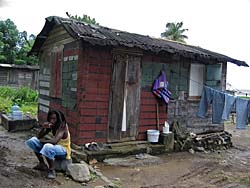 |
As we climbed it got pretty misty. We could not see down to the ocean (which I understood that you can see on a clear day). We could also not see the crater at the top. It was eerie. As we hiked, it felt like the world was being swallowed up behind us and we had to keep going into the unknown. Of course it was really just because we were in the clouds.
Finally, around 12:20 we reached the crater. We stood on the rim of the crater of the active volcano. It was pretty wide, so wide we could not see the other side. It had steep green sides and there was a large cone in the center which was built up from recent eruptions. There was no obvious volcanic activity except some steam off one side of the cone. Elroy showed us where the trail went around the rim for those foolish enough to continue the hike down the other side (the trail on the leeward side is much longer).
Meanwhile, we went back down the trail a little and had lunch. Daphne and I finished the third water at lunch, leaving one more bottle of water for the trip down. By now my shirt was completely drenched in sweat (4). After a brief lunch break, we started the descent.
It was during the descent that saw the first set of other people. We had reached the top before anyone else that day, but on the way down we pasted three or four groups of people going up. Most of the groups we passed were larger than our group of three people. The other groups were obviously organized tours from one place or another.
Going down was tough. At the start (near the crater) there were no stairs and you had to be very careful to avoid sliding down the loose gravel on the trail. When we reached the rain forest, you just had to be careful not to blow out your knees. That's why Daphne brought the hiking poles, while I had the backpack and my trusty camera.
 |
When we got to the hut (three-quarters of the way down), there were a few locals hanging out. We walked past them and on to the trail head. We got the trail head with one half of a bottle of water and 15 minutes to spare. Elroy's cell phone was not working so we had to wait for our ride; which showed up promptly at 2:30pm.
The ride back was very similar to the ride out. We stopped a couple of times so I could take pictures, and part of the way back we took a different route, around the rim of the largest valley in the island, instead of along the coast. Eventually we reached Kingstown and then went past, to the place where Brian was to meet us.
Up to that point, the whole trip so far was dry, no rain, only sweat. But as we pulled into the bay where we would board the boat, the rain started coming down really hard. Out came the raincoats and we ran for the boat. It was a wet ride back and our sneakers, which had been dry the whole day, were now wet (not to mention everything else) (5). Pulling into Petit Byahaut, we saw that our sailboat for the next leg of our journey, Fortitude, has arrived and was moored in the bay. You will have to find out about that on the next page of the journal.
Coming down to dinner we brought our Lost Cities game to play while waiting for our food. But lo and behold there were other people there at the restaurant/bar. There were two couples from different boats that had moored in the bay. One couple had been sailing for the last two months and the other for the last 20 months. The second couple had brought their kids with them (on the boat, but not ashore). I couldn't imagine having three kids (two of them teenagers) with me on a sailboat.
Not long after we start gabbing, we were joined by Fortitude's captain, Jeremy, and his crew, Vanessa. We all sat around talking for a bit while dinner was being cooked. Chucky did his usual wonderful job with dinner. It was Mahi Mahi with a papaya sauce. I'm not quite sure what the side dish was. I think it was dasheen (taro leaves) that was put between two biscuit-like squares. They weren't real biscuits, I haven't a clue as to what they were, but they were good anyway.
After dinner, both of us were exhausted because of the long hike and we went to bed quickly.
Footnote 1: Brian, knowing that we had to leave early for the hike, prepare breakfast a little early for us.
Footnote 2: On St. Vincent, all the banana bunches are grown inside blue plastic bags. Elvis explained that it was required by European Union regulations, since the bananas grown on St. Vincent were shipped to Europe.
Footnote 3: St. Vincent and the Grenadines has its own currency. We never bothered to exchange money on the trip because we only had to pay the two resorts and the sailboat captain, and they all took US traveler's checks or credit cards. When we bought drinks in Georgetown, they were also happy to take our US currency, although change was in St. Vincent bills. I ended up giving Elvis the St. Vincent currency as a tip at the end of the trip since we did not think that we would need it.
Footnote 4: Did I mention that the trail went up steeply?
Footnote 5: My shirt never dried. We left it hanging up over night but because of the humidity, it was just as wet in the morning. When we packed, my shirt and the other wet things just got stuffed into a pocket of our duffle bag, and stayed there until we reached Petit St. Vincent, five days later. Needless to say, they smelled really bad when we finally pulled them out.
![]()
![]()
Introduction |
July 14th (travel day) |
July 15th (Falls of Baleine) |
July 16th (Petit Byahaut) |
July 17th (La Soufriere hike)
July 18th (sail to Bequia) |
July 19th (Union Island) |
July 20th (Sandy Island) |
July 21th (Tobago Cays) |
July 22th (Petit Tobac)
July 23th (arrive at PSV) |
July 24th (West Side Beach) |
July 25th (Atlantic Beach) |
July 26th (Mopion) |
July 27th (travel day)
Photo Galleries
GouldHome | Travel Journals
Text and images © Copyright 2004 Daphne and Joel Gould. All Rights Reserved.
For comments or suggestions about this site contact Daphne Gould.